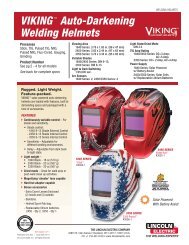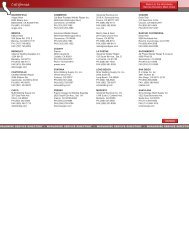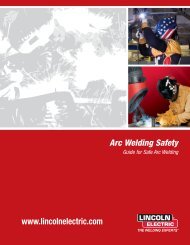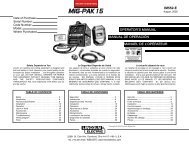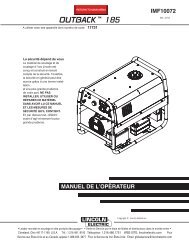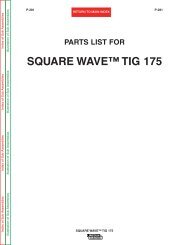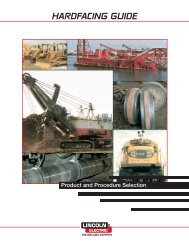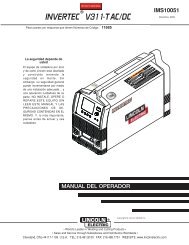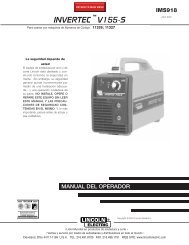- Page 1 and 2:
C1.10 www.lincolnelectric.com Weldi
- Page 3:
GAS-SHIELDED FLUX-CORED (FCAW-G) WI
- Page 6 and 7:
Detailed Table of Contents Stick St
- Page 8 and 9:
Detailed Table of Contents Submerge
- Page 10 and 11:
Detailed Table of Contents Aluminum
- Page 12 and 13:
Catalog User Guide 4 7 8 9 10 11 12
- Page 14 and 15:
INTRODUCTION 12 ı THE LINCOLN ELEC
- Page 16 and 17:
INTRODUCTION Q Lot Certifications C
- Page 18 and 19:
INTRODUCTION Disclaimers 16 ı THE
- Page 20 and 21:
STICK (SMAW) ELECTRODE Fleetweld ®
- Page 22 and 23:
STICK (SMAW) ELECTRODE Fleetweld ®
- Page 24 and 25:
STICK (SMAW) ELECTRODE Fleetweld ®
- Page 26 and 27:
STICK (SMAW) ELECTRODE Fleetweld ®
- Page 28 and 29:
STICK (SMAW) ELECTRODE Jetweld ® H
- Page 30 and 31:
STICK (SMAW) ELECTRODE Excalibur ®
- Page 32 and 33:
STICK (SMAW) ELECTRODE Jet-LH ® Lo
- Page 34 and 35:
STICK (SMAW) ELECTRODE Excalibur ®
- Page 36 and 37:
STICK (SMAW) ELECTRODE Shield-Arc®
- Page 38 and 39:
STICK (SMAW) ELECTRODE Shield-Arc®
- Page 40 and 41:
STICK (SMAW) ELECTRODE Excalibur ®
- Page 42 and 43:
STICK (SMAW) ELECTRODE Excalibur ®
- Page 44 and 45:
STICK (SMAW) ELECTRODE Excalibur ®
- Page 46 and 47:
STICK (SMAW) ELECTRODE Excalibur ®
- Page 48 and 49:
STICK (SMAW) ELECTRODE Notes 46 ı
- Page 50 and 51:
MIG (GMAW) WIRE SuperGlide® Typica
- Page 52 and 53:
MIG (GMAW) WIRE SuperGlide® Typica
- Page 54 and 55:
MIG (GMAW) WIRE SuperArc® Typical
- Page 56 and 57:
MIG (GMAW) WIRE SuperArc® Typical
- Page 58 and 59:
MIG (GMAW) WIRE SuperArc® Typical
- Page 60 and 61:
MIG (GMAW) WIRE SuperArc® Typical
- Page 62 and 63:
MIG (GMAW) WIRE SuperArc® Typical
- Page 64 and 65:
MIG (GMAW) WIRE SuperArc® Capable
- Page 66 and 67:
TIG (GTAW) CUT LENGTHS Lincoln® Ty
- Page 68 and 69:
MIG (GMAW) & TIG (GTAW) CONSUMABLES
- Page 70 and 71:
METAL-CORED WIRE Metalshield ® Mil
- Page 72 and 73:
Structural Welding Code Seismic Sup
- Page 74 and 75:
METAL-CORED WIRE Metalshield ® Mil
- Page 76 and 77:
METAL-CORED WIRE Metalshield ® Low
- Page 78 and 79:
METAL-CORED WIRE Metalshield ® Low
- Page 80 and 81:
METAL-CORED WIRE Metalshield ® Low
- Page 82 and 83:
METAL-CORED CONSUMABLES Notes 80 ı
- Page 84 and 85:
FLUX-CORED SELF-SHIELDED (FCAW-S) W
- Page 86 and 87:
Structural Welding Code Seismic Sup
- Page 88 and 89:
FLUX-CORED SELF-SHIELDED (FCAW-S) W
- Page 90 and 91:
FLUX-CORED SELF-SHIELDED (FCAW-S) W
- Page 92 and 93:
FLUX-CORED SELF-SHIELDED (FCAW-S) W
- Page 94 and 95:
Structural Welding Code Seismic Sup
- Page 96 and 97:
Structural Welding Code Seismic Sup
- Page 98 and 99:
Structural Welding Code Seismic Sup
- Page 100 and 101:
Structural Welding Code Seismic Sup
- Page 102 and 103:
FLUX-CORED SELF-SHIELDED (FCAW-S) W
- Page 104 and 105:
FLUX-CORED SELF-SHIELDED (FCAW-S) W
- Page 106 and 107:
FLUX-CORED SELF-SHIELDED (FCAW-S) W
- Page 108 and 109:
Structural Welding Code Seismic Sup
- Page 110 and 111:
Structural Welding Code Seismic Sup
- Page 112 and 113:
Structural Welding Code Seismic Sup
- Page 114 and 115:
FLUX-CORED GAS-SHIELDED (FCAW-G) WI
- Page 116 and 117:
FLUX-CORED GAS-SHIELDED (FCAW-G) WI
- Page 118 and 119:
FLUX-CORED GAS-SHIELDED (FCAW-G) WI
- Page 120 and 121:
FLUX-CORED GAS-SHIELDED (FCAW-G) WI
- Page 122 and 123:
FLUX-CORED GAS-SHIELDED (FCAW-G) WI
- Page 124 and 125:
FLUX-CORED GAS-SHIELDED (FCAW-G) WI
- Page 126 and 127:
FLUX-CORED GAS-SHIELDED (FCAW-G) WI
- Page 128 and 129:
FLUX-CORED GAS-SHIELDED (FCAW-G) WI
- Page 130 and 131:
Structural Welding Code Seismic Sup
- Page 132 and 133:
FLUX-CORED GAS-SHIELDED (FCAW-G) WI
- Page 134 and 135:
FLUX-CORED GAS-SHIELDED (FCAW-G) WI
- Page 136 and 137:
Structural Welding Code Seismic Sup
- Page 138 and 139:
FLUX-CORED GAS-SHIELDED (FCAW-G) WI
- Page 140 and 141:
FLUX-CORED GAS-SHIELDED (FCAW-G) WI
- Page 142 and 143:
Structural Welding Code Seismic Sup
- Page 144 and 145:
Structural Welding Code Seismic Sup
- Page 146 and 147:
Structural Welding Code Seismic Sup
- Page 148 and 149:
FLUX-CORED GAS-SHIELDED (FCAW-G) WI
- Page 150 and 151:
FLUX-CORED GAS-SHIELDED (FCAW-G) WI
- Page 152 and 153:
FLUX-CORED GAS-SHIELDED (FCAW-G) WI
- Page 154 and 155:
FLUX-CORED GAS-SHIELDED (FCAW-G) WI
- Page 156 and 157:
FLUX-CORED GAS-SHIELDED (FCAW-G) WI
- Page 158 and 159:
FLUX-CORED GAS-SHIELDED (FCAW-G) WI
- Page 160 and 161:
SUBMERGED ARC (SAW) FLUX Lincolnwel
- Page 162 and 163:
SUBMERGED ARC (SAW) FLUX Lincolnwel
- Page 164 and 165:
SUBMERGED ARC (SAW) FLUX Lincolnwel
- Page 166 and 167:
SUBMERGED ARC (SAW) FLUX Lincolnwel
- Page 168 and 169:
SUBMERGED ARC (SAW) FLUX Lincolnwel
- Page 170 and 171:
SUBMERGED ARC (SAW) FLUX Lincolnwel
- Page 172 and 173:
SUBMERGED ARC (SAW) FLUX Lincolnwel
- Page 174 and 175:
SUBMERGED ARC (SAW) FLUX Lincolnwel
- Page 176 and 177:
Lincolnweld ® Features the chemica
- Page 178 and 179:
SUBMERGED ARC (SAW) FLUX Lincolnwel
- Page 180 and 181:
SUBMERGED ARC (SAW) FLUX Lincolnwel
- Page 182 and 183:
SUBMERGED ARC (SAW) ELECTRODE Linco
- Page 184 and 185:
SUBMERGED ARC (SAW) ELECTRODE Linco
- Page 186 and 187:
SUBMERGED ARC (SAW) ELECTRODE Linco
- Page 188 and 189:
SUBMERGED ARC (SAW) ELECTRODE Linco
- Page 190 and 191:
SUBMERGED ARC (SAW) ELECTRODE Linco
- Page 192 and 193:
SUBMERGED ARC (SAW) ELECTRODE Linco
- Page 194 and 195:
SUBMERGED ARC (SAW) CONSUMABLES Not
- Page 196 and 197:
STICK (SMAW) ELECTRODE Excalibur®
- Page 198 and 199:
STICK (SMAW) ELECTRODE Excalibur ®
- Page 200 and 201:
STICK (SMAW) ELECTRODE Excalibur ®
- Page 202 and 203:
STICK (SMAW) ELECTRODE Excalibur ®
- Page 204 and 205:
STICK (SMAW) ELECTRODE Excalibur ®
- Page 206 and 207:
MIG (GMAW) WIRE Blue Max® Stainles
- Page 208 and 209:
MIG (GMAW) WIRE Blue Max® Stainles
- Page 210 and 211:
MIG (GMAW) WIRE Blue Max ® Stainle
- Page 212 and 213:
MIG (GMAW) WIRE Blue Max® Stainles
- Page 214 and 215:
MIG (GMAW) WIRE Blue Max® Stainles
- Page 216 and 217:
FLUX-CORED GAS-SHIELDED (FCAW-G) WI
- Page 218 and 219:
FLUX-CORED GAS-SHIELDED (FCAW-G) WI
- Page 220 and 221:
FLUX-CORED GAS-SHIELDED (FCAW-G) WI
- Page 222 and 223:
FLUX-CORED GAS-SHIELDED (FCAW-G) WI
- Page 224 and 225:
FLUX-CORED GAS-SHIELDED (FCAW-G) WI
- Page 226 and 227:
SUBMERGED ARC (SAW) ELECTRODE Linco
- Page 228 and 229:
SUBMERGED ARC (SAW) ELECTRODE Linco
- Page 230 and 231:
SUBMERGED ARC (SAW) FLUX Lincolnwel
- Page 232 and 233:
TIG (GTAW) CUT LENGTHS Lincoln® St
- Page 234 and 235:
TIG (GTAW) CUT LENGTHS Lincoln® St
- Page 236 and 237:
METAL-CORED (GMAW-C) WIRE Outershie
- Page 238 and 239:
HARDFACING STICK (SMAW) ELECTRODE W
- Page 240 and 241:
HARDFACING STICK (SMAW) ELECTRODE W
- Page 242 and 243:
HARDFACING STICK (SMAW) ELECTRODE W
- Page 244 and 245:
HARDFACING STICK (SMAW) ELECTRODE W
- Page 246 and 247:
HARDFACING STICK (SMAW) ELECTRODE W
- Page 248 and 249:
HARDFACING METAL-CORED GAS-SHIELDED
- Page 250 and 251:
HARDFACING METAL-CORED (GMAW-C) WIR
- Page 252 and 253:
HARDFACING FLUX-CORED SELF-SHIELDED
- Page 254 and 255:
HARDFACING FLUX-CORED SELF-SHIELDED
- Page 256 and 257:
HARDFACING FLUX-CORED SELF-SHIELDED
- Page 258 and 259:
HARDFACING FLUX-CORED SELF-SHIELDED
- Page 260 and 261:
HARDFACING FLUX-CORED SELF-SHIELDED
- Page 262 and 263:
HARDFACING METAL-CORED SUBMERGED AR
- Page 264 and 265:
HARDFACING METAL-CORED SUBMERGED AR
- Page 266 and 267:
HARDFACING METAL-CORED SUBMERGED AR
- Page 268 and 269:
HARDFACING METAL-CORED SUBMERGED AR
- Page 270 and 271:
HARDFACING METAL-CORED SUBMERGED AR
- Page 272 and 273:
HARDFACING METAL-CORED SUBMERGED AR
- Page 274 and 275:
HARDFACING METAL-CORED SUBMERGED AR
- Page 276 and 277:
HARDFACING METAL-CORED SUBMERGED AR
- Page 278 and 279:
HARDFACING SUBMERGED ARC (SAW) FLUX
- Page 280 and 281:
HARDFACING SUBMERGED ARC (SAW) FLUX
- Page 282 and 283:
MIG (GMAW) WIRE SuperGlaze Aluminum
- Page 284 and 285:
MIG (GMAW) WIRE SuperGlaze Aluminum
- Page 286 and 287:
MIG (GMAW) WIRE SuperGlaze Aluminum
- Page 288 and 289:
SuperGlaze ® MIG (GMAW) WIRE Alumi
- Page 290 and 291:
TIG (GTAW) CUT LENGTHS SuperGlaze A
- Page 292 and 293:
ALUMINUM & CAST IRON CONSUMABLES No
- Page 294 and 295:
PIPELINER ® STICK (SMAW) ELECTRODE
- Page 296 and 297:
PIPELINER ® STICK (SMAW) ELECTRODE
- Page 298 and 299:
PIPELINER ® STICK (SMAW) ELECTRODE
- Page 300 and 301:
PIPELINER ® STICK (SMAW) ELECTRODE
- Page 302 and 303:
PIPELINER ® STICK (SMAW) ELECTRODE
- Page 304 and 305:
Pipeliner® Welding Positions All P
- Page 306 and 307:
PIPELINER ® FLUX-CORED SELF-SHIELD
- Page 308 and 309:
PIPELINER ® FLUX-CORED GAS-SHIELDE
- Page 310 and 311:
PIPELINER ® FLUX-CORED GAS-SHIELDE
- Page 312 and 313:
PIPELINER ® CONSUMABLES Electrode
- Page 314 and 315:
PIPELINER ® CONSUMABLES Electrode
- Page 316 and 317:
PIPELINER ® CONSUMABLES EN and ISO
- Page 318 and 319:
Agency Approvals NOTE: Approvals ar
- Page 320 and 321:
PIPELINER ® CONSUMABLES Notes 318
- Page 322 and 323:
Power Generation & Nuclear Lincoln
- Page 324 and 325:
BATCH | STICK (SMAW) ELECTRODE Exca
- Page 326 and 327:
STICK (SMAW) ELECTRODE Excalibur®
- Page 328 and 329:
STICK (SMAW) ELECTRODE Excalibur®
- Page 330 and 331:
BATCH | MIG (GMAW) WIRE SuperArc®
- Page 332 and 333:
BATCH | MIG (GMAW) WIRE SuperArc®
- Page 334 and 335: BATCH | MIG (GMAW) WIRE Blue Max®
- Page 336 and 337: BATCH | MIG (GMAW) WIRE Blue Max®
- Page 338 and 339: BATCH | MIG (GMAW) WIRE Blue Max®
- Page 340 and 341: BATCH | MIG (GMAW) WIRE Blue Max®
- Page 342 and 343: TIG (GTAW) CUT LENGTHS Lincoln® Lo
- Page 344 and 345: BATCH | TIG (GTAW) CUT LENGTHS Linc
- Page 346 and 347: BATCH | ORBITAL TIG (GTAW) WIRE Sup
- Page 348 and 349: BATCH | FLUX-CORED GAS-SHIELDED (FC
- Page 350 and 351: FLUX-CORED GAS-SHIELDED (FCAW-G) WI
- Page 352 and 353: SUBMERGED ARC (SAW) FLUX AND WIRE C
- Page 354 and 355: SUBMERGED ARC (SAW) WIRE AND FLUX L
- Page 356 and 357: SUBMERGED ARC (SAW) WIRE AND FLUX L
- Page 358 and 359: PACKAGING Tubes, Cans & Cartons 5 l
- Page 360 and 361: PACKAGING Reels & Stem REELS Wire T
- Page 362 and 363: PACKAGING Spools A SPOOLS Wire Type
- Page 364 and 365: PACKAGING Coils, Boxes & Bags COILS
- Page 366 and 367: PACKAGING Drums & Pails DRUMS Wire
- Page 368 and 369: PACKAGING Storage & Handling Stick
- Page 370 and 371: PACKAGING Storage & Handling Metal-
- Page 372 and 373: PACKAGING Storage & Handling Submer
- Page 374 and 375: APPENDIX AWS Classification System
- Page 376 and 377: APPENDIX AWS Classification System
- Page 378 and 379: APPENDIX AWS Classification System
- Page 380 and 381: APPENDIX AWS Classification System
- Page 382 and 383: APPENDIX Stick Electrode Types of C
- Page 386 and 387: APPENDIX Submerged Arc Flux/Wire Se
- Page 388 and 389: APPENDIX Aluminum Typical Operating
- Page 390 and 391: APPENDIX Aluminum Typical Joint Des
- Page 392 and 393: APPENDIX Innershield® Wire Selecti
- Page 394 and 395: APPENDIX Agency Approvals NOTE: App
- Page 396 and 397: APPENDIX Agency Approvals NOTE: App
- Page 398 and 399: APPENDIX Agency Approvals NOTE: App
- Page 400 and 401: APPENDIX Agency Approvals NOTE: App
- Page 402 and 403: APPENDIX Agency Approvals NOTE: App
- Page 404 and 405: APPENDIX Agency Approvals NOTE: App
- Page 406 and 407: APPENDIX Safety Guidelines Diesel e
- Page 408 and 409: APPENDIX Safety Guidelines ARC RAYS
- Page 410 and 411: APPENDIX Safety Guidelines CYLINDER
- Page 412 and 413: APPENDIX Safety Guidelines The gase
- Page 414 and 415: APPENDIX Notes
- Page 416: THE LINCOLN ELECTRIC COMPANY 22801



